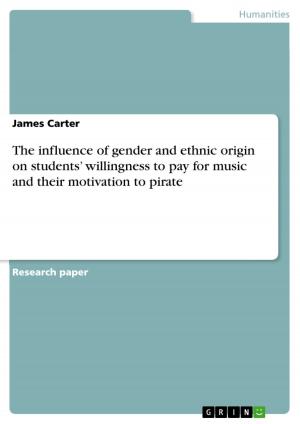Imagined communities - What Makes a Readership Share a Certain Idea of Newspapers
What Makes a Readership Share a Certain Idea of Newspapers
Nonfiction, Entertainment, Drama, Anthologies| Author: | Paul Vierkant | ISBN: | 9783638544726 |
| Publisher: | GRIN Publishing | Publication: | September 13, 2006 |
| Imprint: | GRIN Publishing | Language: | English |
| Author: | Paul Vierkant |
| ISBN: | 9783638544726 |
| Publisher: | GRIN Publishing |
| Publication: | September 13, 2006 |
| Imprint: | GRIN Publishing |
| Language: | English |
Seminar paper from the year 2005 in the subject American Studies - Culture and Applied Geography, grade: 1,3, Free University of Berlin (John-F.-Kennedy-Institut), course: History of News, 6 entries in the bibliography, language: English, abstract: 'Paper is patient! 'my high school physics teacher used to say, when he corrected our exams. As he explained to us, he had heard this old printers saying many times before from his father, who was in the printing business himself. This motto is more than simply a justification for the laziness of my teacher who almost never corrected our tests on time. Since it comes out of the printing business - a business hundreds of years old - it has a broader meaning. It expresses the enduring existence of the written word. Hence, letters, black on white, are records of people's thoughts and opinions at specific points in time, from early signs of human existence on cave walls to digital letters on our modern-day computer screens. Newspapers as a medium for writing are of special interest to historians as well as to ordinary people like you and me. Throughout history newspapers have reflected society. However, it would be an over-simplification to reduce the complexity of newspapers to the mere role of mirroring. They give us useful information about editors, journalists and authors. Their patient words waiting to be read become vibrant thoughts - even though reader and source might be years apart. It is the dichotomy of individual and collective experience in reading that creates a readership. Benedict Anderson's concept of imagined communities fits into this context incredibly well. Although a reader might not know all the other readers of his or her newspaper, they still have one thing in common - they have all held the same information in their hands and read the same news. Thus the reader - being aware of this indirectly shared experience - imagines his community of fellow readers. While Anderson refers to communities that overcome all distances I would apply his model to distances in time. It is because of the lasting effect of the written word that, although I am culturally embedded in the 21st century, I can still read, be impressed and influenced by, or even identify with an article that is almost one hundred years old. I leaf through the same pages, look at the same pictures, and think about the same author as did other readers back then. This process - as an extension of Anderson's theory - makes me a part of an imagined community that knows no borders, neither in space, nor in time.
Seminar paper from the year 2005 in the subject American Studies - Culture and Applied Geography, grade: 1,3, Free University of Berlin (John-F.-Kennedy-Institut), course: History of News, 6 entries in the bibliography, language: English, abstract: 'Paper is patient! 'my high school physics teacher used to say, when he corrected our exams. As he explained to us, he had heard this old printers saying many times before from his father, who was in the printing business himself. This motto is more than simply a justification for the laziness of my teacher who almost never corrected our tests on time. Since it comes out of the printing business - a business hundreds of years old - it has a broader meaning. It expresses the enduring existence of the written word. Hence, letters, black on white, are records of people's thoughts and opinions at specific points in time, from early signs of human existence on cave walls to digital letters on our modern-day computer screens. Newspapers as a medium for writing are of special interest to historians as well as to ordinary people like you and me. Throughout history newspapers have reflected society. However, it would be an over-simplification to reduce the complexity of newspapers to the mere role of mirroring. They give us useful information about editors, journalists and authors. Their patient words waiting to be read become vibrant thoughts - even though reader and source might be years apart. It is the dichotomy of individual and collective experience in reading that creates a readership. Benedict Anderson's concept of imagined communities fits into this context incredibly well. Although a reader might not know all the other readers of his or her newspaper, they still have one thing in common - they have all held the same information in their hands and read the same news. Thus the reader - being aware of this indirectly shared experience - imagines his community of fellow readers. While Anderson refers to communities that overcome all distances I would apply his model to distances in time. It is because of the lasting effect of the written word that, although I am culturally embedded in the 21st century, I can still read, be impressed and influenced by, or even identify with an article that is almost one hundred years old. I leaf through the same pages, look at the same pictures, and think about the same author as did other readers back then. This process - as an extension of Anderson's theory - makes me a part of an imagined community that knows no borders, neither in space, nor in time.















